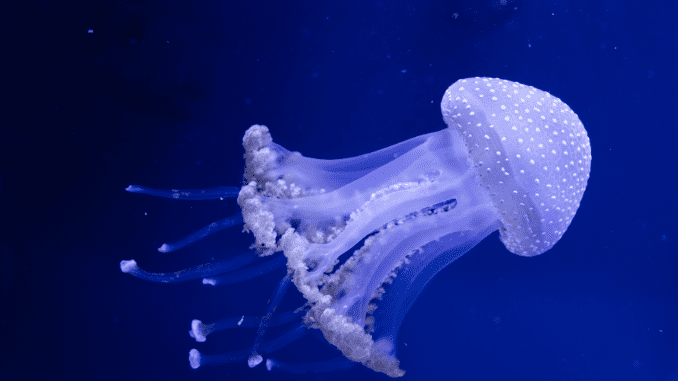
Radial symmetry is a type of body symmetry in different regions and directions of the body. It is found in both natural objects and organisms and man-made objects (clock, wheel).
If a body is not divisible into equal halves by any plane it is called asymmetrical as in sponges. An animal is said to be symmetrical if the body is divisible into equal halves by any plane. In this topic, we will know in detail about radial symmetry.
Definition
Radial symmetry is the regular arrangement of body parts around a central axis in organisms. The line joining the mouth and the aboral end is called the central axis. Their body can be divided into equal halves by any number of planes passing through the center from top to bottom.
Biological relevance
Radial symmetry is advantageous to sedentary and slow-moving aquatic animals. That is radial symmetry is more common in aquatic animals. As it helps them to develop appendages all around the mouth and gather food from all directions. Most animals living in the sea exhibit radial symmetry. Radial symmetry is the result of specific genetic and developmental conditions.
Overview of Symmetry in Biology
- Symmetry is the fundamental property of the animal body plans that emerged over half a billion years ago during the Cambrian period.
- It is an adaptation to the habitat of an animal.
- While a few animal groups display radial symmetry like Coelenterates and echinoderms, the majority of the animals are bilaterally symmetrical.
Other than animals plants also exhibit radial symmetry. Floral parts like petals, sepals, carpel, and stamens occur symmetrically around the floral axis.
Viruses also exhibit radial symmetry in the arrangement of their protein coats.
Key characteristics of radial symmetry
Radial symmetry is generally of four types.
1. Biradial symmetry
The body can be divided into two similar halves only by one or two vertical planes.
2. Tetramerous symmetry
The body parts are arranged in fours or multiple of four. e.g., Jellyfish.
3. Pentamerous symmetry
The body parts are arranged in five or multiples of five, e.g., starfish (Echinoderms).
4. Hexamerous symmetry
The body parts are arranged in six or multiples of six, e.g., Sea anemone.
Characteristics
- Radially symmetrical animals have a top and bottom. There is no distinction between front and back. Left and right sides do not exist.
- The side where the mouth is present is the oral side and the opposite side is the aboral side without a mouth.
- Animals with radial symmetry can move in all directions.
- Show slow movements or no movement at all.
- The central nervous system is absent. Sensory structures are scattered around the body.
- Show the ability to regenerate lost body parts,e.g. sea stars.
Radial symmetry in Organisms
In the animal kingdom, radially symmetrical phyla are Porifera, Coelentrata, Ctenophora, and Echinodermata.
Jellyfish
- Radially symmetrical, marine invertebrate with gelatinous, umbrella-shaped body.
- The presence of tentacles for stinging its prey and capturing it.
- Jellyfish lack a brain, but the presence of nerve net controls swimming, feeding, and response to stimuli.

Sea Urchin
- Invertebrates belonging to phylum Echinodermata, are found on or near the ocean floor.
- Sea urchins lack eyes but their tube feet allow them to detect light and dark.
- Their bodies are covered in spines and are black, orange, yellow, and green.

Sea Anemone
- Radially symmetrical organisms with colorful tentacles, attached to the substratum of oceans by pedal disc.
- They feed on tiny plankton and fish which are captured by the stinging tentacles.
- Live in a symbiotic relationship with clownfish and hermit crabs benefiting each other.
- Radial symmetry is also seen in plant parts like flowers and the internal tissue organization of roots and stems.

China rose (Hibiscus)
- An angiosperm, the dicot plant of the Malvaceae family, and the sunflower are actinomorphic (radially symmetrical) flowers.
- The flowers are large, showy, variously colored, and bear five petals (pentamerous).
- Such arrangements provide an advantage for pollination by insects.

Vascular bundles in angiosperm roots
- The vascular bundles in the roots of both monocot and dicot plants show radial arrangement.
- The xylem and phloem tissues are arranged on alternate radii of an axis.
Fruits of apple
- These fruits show an internal radial arrangement of their seeds.
- The fruits of apple are false fruits as they do not develop from the ovary of the flower.

Adaptation and functionality
- These organisms have an equal distribution of body parts and sense organs that help them detect environmental stimuli easily.
- Such an arrangement also helps in gathering food easily from passing water around the mouth.
- Regeneration or rearrangement of radial parts is easier for radially symmetrical animals. This helps in adjusting to the surroundings easily.
- The male medusa releases sperm in the water at sexual maturity. The female medusa uses its tentacles to direct the sperms into its gastrovascular cavity. This ensures fertilization and continuity of species
Evolutionary aspects of radial symmetry
- All organisms differ in size, shape, and other aspects. One common thing that connects all forms is body symmetry. It has been supposed to be inherited from some common ancestor.
- With two-sided symmetry, the bilaterians are the largest group of organisms prevailing on Earth. However, a few organisms belonging to Cnidaria and Echinodermata show radial symmetry.
- Fossil records dating 450 million years back show ancient organisms with symmetry. They were unique animals that grew symmetrically.
- During the Cambrian period, the bilaterians became more successful.
- Hence bilaterians inhabited the land too. Their body arrangements made their movement purposeful, and directional. This gave the predator-prey relationship more meaning.
- Along another line of evolution, some animals developed another form of symmetry – radial symmetry.
- Animals of phylum Cnidaria are also classified as radiata.
- Animals like jellyfish, sea anemones, and hydra show radial symmetry, they are slow-moving or sedentary animals. They possess nerve cells surrounding their body but no central nervous system as such.
- Radial symmetry allows the organisms to encounter and feel the environment from all sides.
- Phylum Ctenophora exhibits biradial symmetry, another form of radial symmetry.
- Members of the phylum Echinodermata also show radial symmetry but the larval stages show bilateral symmetry. This is also termed secondary radial symmetry.
- So due to selective pressure, they may have been forced to live a radial life form. It is presumed that they have evolved from bilaterally symmetrical ancestors.
- Radially symmetrical animals are exclusively found in aquatic environments.
Comparison of radial and bilateral symmetry
Radial symmetry |
Bilateral symmetry |
| The body when divided through a central axis along any plane identical halves are got. | Can be divided into two halves only in one plane. |
| The body cannot be divided into left and right sides. | The sagittal plane(vertical axis) divides the body into left and right sides. |
| Similar body parts are arranged regularly around the central axis. One half is not the mirror image of the other. | Similar body parts are arranged on both left and right sides equally. Thus each side is a mirror image of the other. |
| It exhibits several special forms like tetramerism, pentamerism, hexamerism, and octamerism. | It does not exhibit any such form. |
| The development of the head (cephalisation) in front of the body is rare. | The development of the head (cephalisation) is a notable feature of bilateral symmetry. |
| The body with radial symmetry does not show a streamlined form. | Bilateral symmetry permits streamlining. |
| Organisms depend on the environment to move them e.g., ocean currents. | Bilateral symmetry creates balance and helps to propel the body in the forward direction. |
| The mouths of these organisms are at the top or at the bottom of the bodies. | The mouth is generally a part of the head and is found on the ventral side of the body. |
| Do not possess tails. | Bilaterally symmetrical animals possess tails in many cases. It plays a major role in sensation and movement. |
| The larvae of some radially symmetrical animals are bilaterally symmetrical. | Bilaterians show the same symmetry through all stages of development. |
Q&A
1. What defines radial symmetry?
The symmetry in which the body parts are arranged around a central axis. The body can be divided into equal halves by any number of planes.
2. What is the difference between radial and bilateral symmetry?
In radial symmetry, the body when divided through a central axis along any plane identical halves.
In bilateral symmetry, the body can be divided into two halves only in one plane.
3. What is an example of radial symmetry in biology?
The jellyfish belonging to the phylum Cnidaria exhibits radial symmetry.
4. What is the difference between radial and symmetry?
Radial is lines diverging in the form of rays from a common centre, or as in the radius of a circle.
Symmetry is the arrangement of body parts so that they are equal on each side of a dividing line.
Summary
- Radial symmetry is the regular arrangement of body parts around a central axis in organisms.
- Their body is divided into equal halves by any number of planes passing through the center from top to bottom. e.g., jellyfish and sea anemones.
- The line joining the mouth and the aboral end is called the central axis.
- Such organisms have oral (mouth ) surfaces. The side without the mouth is the aboral surface.
- Radial symmetry is also noticed in phylum echinodermata.
- These organisms are slow-moving, floating, or sedentary. They
- Larval stages of phylum echinodermata exhibit bilateral symmetry. This is also termed secondary radial symmetry. They have evolved from bilaterally symmetrical animals.
- Bilateral symmetry is another type of symmetry found in animals. This symmetry divides the organism into two halves only in one plane.·
- Animals with bilateral symmetry often have streamlined bodies. They show definite directional movement with increased intelligence.
- A head is formed at the anterior end. Tail in the posterior end is also seen in many cases.
- At some point of time during evolution selective pressure, and environmental factors led to the development of radial symmetry. These life forms are found in aquatic environments only.
Reference
Principles of Comparative anatomy of invertebrates: Vol -I By Beklemishev V.N.
